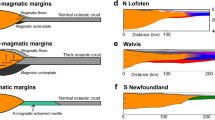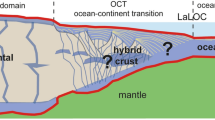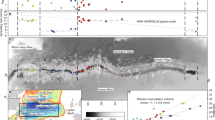Abstract
Rifting and magmatism are fundamental geological processes that shape the surface of our planet. A relationship between the two is widely acknowledged but its precise nature has eluded geoscientists and remained controversial. Largely on the basis of detailed observations from the North Atlantic Ocean, mantle temperature was identified as the primary factor controlling magmatic production1, with most authors seeking to explain observed variations in volcanic activity at rifted margins in terms of the mantle temperature at the time of break-up2,3. However, as more detailed observations have been made at other rifted margins worldwide, the validity of this interpretation and the importance of other factors in controlling break-up style have been much debated4,5,6,7. One such observation is from the northwest Indian Ocean, where, despite an unequivocal link between an onshore flood basalt province, continental break-up and a hot-spot track leading to an active ocean island volcano, the associated continental margins show little magmatism5,8. Here we reconcile these observations by applying a numerical model that accounts explicitly for the effects of earlier episodes of extension. Our approach allows us to directly compare break-up magmatism generated at different locations and so isolate the key controlling factors. We show that the volume of rift-related magmatism generated, both in the northwest Indian Ocean and at the better-known North Atlantic margins, depends not only on the mantle temperature but, to a similar degree, on the rift history. The inherited extensional history can either suppress or enhance melt generation, which can explain previously enigmatic observations.
This is a preview of subscription content, access via your institution
Access options
Subscribe to this journal
Receive 51 print issues and online access
$199.00 per year
only $3.90 per issue
Buy this article
- Purchase on Springer Link
- Instant access to full article PDF
Prices may be subject to local taxes which are calculated during checkout




Similar content being viewed by others
References
White, R. S. & McKenzie, D. Magmatism at rift zones: the generation of volcanic continental margins and flood basalts. J. Geophys. Res. 94, 7685–7729 (1989)
Keen, C. E. & Boutilier, R. R. Interaction of rifting and hot horizontal plume sheets at volcanic margins. J. Geophys. Res. 105, 13375–13387 (2000)
Nielsen, T. K. & Hopper, J. R. From rift to drift: mantle melting during continental breakup. Geochem. Geophys. Geosyst. 5, Q07003 (2004)
Hopper, J. R., Mutter, J. C., Larson, R. L. & Mutter, C. Z. Magmatism and rift margin evolution: evidence from northwest Australia. Geology 20, 853–857 (1992)
Minshull, T. A., Lane, C. I., Collier, J. S. & Whitmarsh, R. B. The relationship between rifting and magmatism in the northeastern Arabian Sea. Nature Geosci. 1, 463–467 (2008)
Lizarralde, D. et al. Variation in styles of rifting in the Gulf of California. Nature 448, 466–469 (2007)
Holbrook, W. S. et al. Seismic structure of the US Mid-Atlantic continental margin. J. Geophys. Res. 99, 17871–17891 (1994)
Collier, J. S. et al. Factors influencing magmatism during continental break-up: new insights from a wide-angle seismic experiment across the conjugate Seychelles-Indian margins. J. Geophys. Res. 114, B03101 (2009)
Storey, M., Duncan, R. A. & Swisher, C. C. III. Paleocene-Eocene thermal maximum and opening of the Northeast Atlantic. Science 316, 587–589 (2007)
Holbrook, W. S. et al. Mantle thermal structure and active upwelling during continental breakup in the North Atlantic. Earth Planet. Sci. Lett. 190, 251–262 (2001)
Bown, J. W. & White, R. S. Effect of finite extension rate on melt generation at rifted continental margins. J. Geophys. Res. 100, 18011–18029 (1995)
Campbell, I. H. Testing the plume theory. Chem. Geol. 241, 153–176 (2007)
Shillington, D. J. et al. Abrupt transition from magma-starved to magma-rich rifting in the eastern Black Sea. Geology 37, 7–10 (2009)
Voss, M., Schmidt-Aursch, M. C. & Jokat, W. Variations in magmatic processes along the East Greenland volcanic margin. Geophys. J. Int. 177, 755–782 (2009)
White, R. S. & McKenzie, D. Mantle plumes and flood basalts. J. Geophys. Res. 100, 17543–17585 (1995)
Reston, T. J. Polyphase faulting during the development of the west Galicia rifted margin. Earth Planet. Sci. Lett. 237, 561–576 (2005)
Simon, K., Huismans, R. S. & Beaumont, C. Dynamical modelling of lithospheric extension and small-scale convection: implications for magmatism during the formation of volcanic rifted margins. Geophys. J. Int. 176, 327–350 (2009)
Armitage, J. J., Henstock, T. J., Minshull, T. A. & Hopper, J. R. Lithospheric controls on melt production during continental breakup at slow rates of extension: application to the North Atlantic. Geochem. Geophys. Geosyst. 10, Q06018 (2009)
Moresi, L. N. & Solomatov, V. S. Numerical investigation of 2D convection with extremely large viscosity variations. Phys. Fluids 7, 2154–2162 (1995)
Collier, J. S. et al. Age of Seychelles-India break-up. Earth Planet. Sci. Lett. 272, 264–277 (2008)
Smith, L. K., White, R. S. & Kusznir, N. J. in Petroleum Geology: North-West Europe and Global Perspectives – Proceedings of the 6th Petroleum Geology Conference (eds Doré, A. G. & Vining, B. A.) 947–956 (Geological Society of London, 2005)
Edwards, J. W. F. Development of the Hatton-Rockall Basin, North-East Atlantic Ocean. Mar. Petrol. Geol. 19, 193–205 (2002)
Shannon, P. M., Moore, J. G., Jacob, A. W. B. & Makris, J. in Petroleum Geology of Northwest Europe: Proceedings of the 4th Conference (ed. Parker, J. R.) 1057–1066 (Geological Society of London, 1993)
Hopper, J. R. et al. Structure of the SE Greenland margin from seismic reflection and refraction data: implications for nascent spreading centre subsidence and asymmetric crustal accretion during North Atlantic opening. J. Geophys. Res. 108, 2269 (2003)
White, R. S. & Smith, L. K. Crustal structure of the Hatton and the conjugate east Greenland rifted volcanic continental margins, NE Atlantic. J. Geophys. Res. 114, B02305 (2009)
Bown, J. W. & White, R. S. Variation with spreading rate of oceanic crust thickness and geochemistry. Earth Planet. Sci. Lett. 121, 435–449 (1994)
Scott, D. R. in Mantle Flow and Melt Generation at Mid-Ocean Ridges (eds Phipps Morgan, J., Blackman, D. K. & Sinton, J. M.) 327–352 (Geophys. Monogr. 71, American Geophysical Union, 1992)
Niu, Y. Mantle melting and melt extraction processes beneath ocean ridges: evidence from abyssal peridotites. J. Petrol. 38, 1047–1074 (1997)
Behn, M. D. & Kelemen, P. B. Relationship between seismic P-wave velocity and the composition of anhydrous igneous and meta-igneous rocks. Geochem. Geophys. Geosyst. 4, 1041 (2003)
Acknowledgements
We are grateful to J. Hopper and R. White for giving us the southeast Greenland and Hatton Bank velocity grids. We are also grateful to T. Henstock for help developing the model. An earlier version of this manuscript was improved by comments from M. Coffin, K. Gallagher, S. Goes, S. Gupta and E. Rohling. This work was partly funded by the UK Natural Environment Research Council.
Author information
Authors and Affiliations
Contributions
J.J.A. designed and performed the numerical experiments. J.J.A., J.S.C. and T.A.M. analysed the geophysical and numerical results, and contributed equally to the writing of the manuscript.
Corresponding author
Ethics declarations
Competing interests
The authors declare no competing financial interests.
Supplementary information
Supplementary Information
This file contains Supplementary Data, Supplementary Figures S1-S2 with legends, Supplementary Table S1and References (PDF 249 kb)
Rights and permissions
About this article
Cite this article
Armitage, J., Collier, J. & Minshull, T. The importance of rift history for volcanic margin formation. Nature 465, 913–917 (2010). https://doi.org/10.1038/nature09063
Received:
Accepted:
Issue Date:
DOI: https://doi.org/10.1038/nature09063
This article is cited by
-
Towards a process-based understanding of rifted continental margins
Nature Reviews Earth & Environment (2023)
-
Hyperextended crustal structure of the Qiongdongnan Basin and subsequent magmatic influence from the Hainan mantle plume
Science China Earth Sciences (2022)
-
Morphotectonic analysis of petroliferous Barmer rift basin (Rajasthan, India)
Journal of Earth System Science (2022)
-
Melt volume at Atlantic volcanic rifted margins controlled by depth-dependent extension and mantle temperature
Nature Communications (2021)
-
Dimensionality and directionality analysis of magnetotelluric data by using different techniques: A case study from northern part of Saurashtra region, India
Journal of Earth System Science (2021)
Comments
By submitting a comment you agree to abide by our Terms and Community Guidelines. If you find something abusive or that does not comply with our terms or guidelines please flag it as inappropriate.



